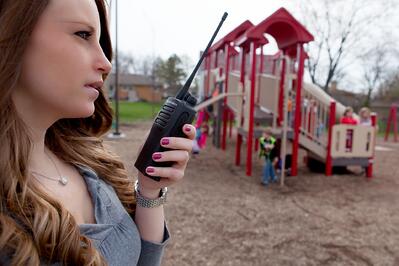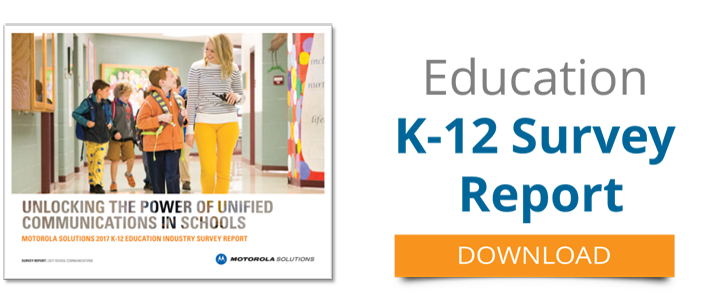 Enhancing safety in schools is a challenge that requires a range of solutions, from changes in behavior to advancements in technology in schools.
Enhancing safety in schools is a challenge that requires a range of solutions, from changes in behavior to advancements in technology in schools.
At the same time, educators are increasingly being challenged to use technology to ensure that they’re nurturing the next generation of innovative students.
Given the budgetary concerns facing campuses large and small, it’s important to invest in technology that’s both effective and cost-effective. But how can you be sure that you’re choosing the right products and systems?
Buyer’s Guide for Technology in Schools
To guide your decision-making when investing in technology in schools, we’ve collected top tips and tricks, including the best tools to enhance safety, questions to ask when selecting technology and several examples of extreme education innovation:
Best Tech Tools to Enhance School Safety
Technology in schools won’t solve every challenge associated with safety in schools, but it’s a key piece of the puzzle. Having the right tools can lead to other changes that make communication easier and campuses safer.
As you’re researching solutions for your own school, district or campus, here are some of the best safety-focused tools out there.
Two-Way Radios
Two-way radios are at the top of our school security list because they provide life-saving communications capabilities, even on a budget and even if the rest of your school technology isn’t as modern as you’d like.
More districts are discovering that radios are more reliable than smartphones, offer greater range, enable push-to-talk, include one-to-many connections and don’t require monthly service fees. And for staff on the go, mobile radios enhance school bus safety as well.
If you’re frustrated with dropped calls and spotty reception, it’s time to consider the benefits of two-way radio.
Radio Applications
Teldio and other Motorola partners have applications built with campus communication and security in mind.
Application features include:
- Seamless connection of two-way radio and non-radio users on and off campus
- Automated alarm notification
- GPS
- Instant contact with emergency personnel
Video Surveillance
Video cameras in schools are nothing new, but as the technology evolves and security concerns change, it’s a good idea to either gradually replace an aging fleet of cameras or upgrade.
Axis network products offer features such as high-resolution video and video encoders that convert analog signals into digital streams that can be transmitted over LAN, internet or intranet.
Questions to Ask When Investing in Technology in Schools
Having the best devices on hand, powering strong school WiFi and developing sophisticated school technology can make the difference in student performance and school security.
As you’re exploring your technology investment, here are some questions to ask.
What Are Our Top Challenges That Technology Can Address?
If your school system has a long list of technology challenges, you’re not alone. More than 150 education leaders and teachers took Education Dive’s 2015 State of Education Technology survey. They described the eight greatest challenges of providing access to education technology in their district as follows, according to EdTech Magazine:
75.9% — Budget limits
53.9% — Inadequate professional training
41.4% — Teachers resistant to change
38.2% — Inadequate network infrastructure
30.9% — Unreliable device/software options
29.6% — No systems to use technology for curriculum
17.8% — Other
13.2% — District doesn’t see immediate need for more technology
When investing in technology to meet your school or district’s challenges, it’s important to look for the investments that will have the most impact and address top priorities. In a nationwide survey conducted by Motorola Solutions, 99 percent of educators said that creating a safe, secure environment is their top priority. And nearly as many cited the need for “always available” communications.
Wireless communications solutions to consider include:
- Switching from cellphones to radios
- Upgrading existing analog radio systems to digital
- Joining a statewide radio for public safety network if it’s available
Is Our School WiFi Up to Speed?
Lightning-fast connectivity is key, particularly for modern classrooms. Investigating how fast your connections need to be to keep up — both now and into the future — is an important step to take in order to be prepared. If you’re interested in testing your school’s internet speed, there’s an online tool for that, developed by the nonprofit Education Superhighway.
If the answer to the above question is no, keep in mind that a system upgrade rather than a full overhaul may be enough to get you back on the fast track.
Who Can Help Us Take Technology in Schools to the Next Level?
Technology in schools is a long-term investment, so who your campus or district works with matters.
Look for wireless communications providers who: offer service for what they sell; have a track record of successful deployments in educational environments; can tailor a solution to meet your specific needs.
Technology in Schools: 6 Examples of Extreme Innovation
From danger-based learning to recreation center takeovers, we’ve gathered some exciting examples of high-tech education.
Transforming Recreation Centers into Tech Hubs
The City of Pittsburgh once ran a “Rec2Tech” demonstration project that turned five municipal recreation centers into interactive learning spaces focused on science, technology, engineering and math (STEM).
During the free after-school program, about 200 youth aged 7-12 got hands-on experience with digital media production, computer programming, sustainable approaches to urban gardening, video game design and 360-degree imaging technology.
Embracing Danger-based Learning
Brightworks school in San Francisco was founded by Gever Tulley, co-author of the book “Fifty Dangerous Things (you should let your children do),” and builds curricula around some of those dangerous things: playing with fire, taking apart home appliances and getting dirty.
The school is based in a 9,000-square-foot former mayonnaise warehouse space that can be adapted and segmented based on what the students are learning at the time.
Finishing With Degrees Not Diplomas
At P-TECH High School in New York City, students complete six years instead of four and finish with an associate’s degree from the New York City College of Technology. The curriculum at the school, which was launched by IBM in 2011, combines traditional classes with mentorship and internships in STEM fields.
Combining Physical Fitness & Tech
Middle school students at Ewa Makai Middle School in Ewa Beach, Hawaii, use iPads in gym class to track each other’s progress, they wear heart monitors during activities and they can download their gym class performance on a special app.
Students say they appreciate being able to track their progress during the year, and their performance on standardized tests has improved since the “Tech P.E.” program was launched.
Award-winning Digital Programs
Maine High School District 207 in suburban Chicago was one of only 11 districts nationwide to receive a Digital Content and Curriculum Achievement Award for its innovations in learning and technology.
The district, which includes three high schools, has been a pioneer in deploying Chromebooks to students, bringing Google Apps to a K-12 environment and transitioning its print books to free or low-cost digital resources.
Combining Tech with the 4 Rs
Students at the Star (Service to All Relations) School in Flagstaff, Arizona, are developing solutions to overcome unclean drinking water, growing their own food and taking cooking classes, all while learning the four Rs of the Navajo culture: Respect, Relationship, Responsibility, and Reasoning.
The school, whose student population is 99 percent Navajo children, was the first elementary school in the country to get all of its energy from solar power.
Making the Grade without Breaking the Bank
ChiComm often gives special pricing to schools and school systems, check our Specials page for details.
